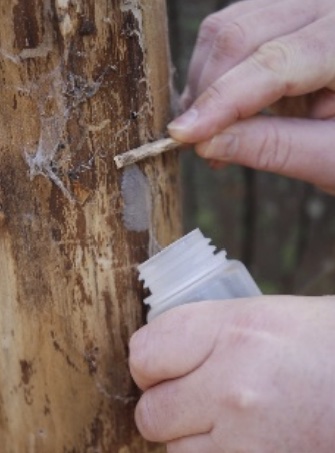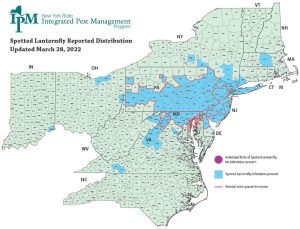Spotted Lanternfly Update — Time for the Nymphs
By Ann M. Mason, Fairfax Master Gardener
Since the first sighting of the Spotted Lanternfly (Lycorma delicatula) in 2018 in Frederick County, Virginia, scientists, Virginia Cooperative Extension agents and master gardeners, nurserymen and county officials throughout Virginia monitor for this invasive insect. As of March 28, 2022, infestations and quarantines are in effect for Frederick, Clarke, Page, Shenandoah and Warren counties, and the City of Winchester, VA. Pennsylvania, New York, New Jersey, Maryland, Ohio and Massachusetts also have quarantine areas. This map may be updated soon to add in Loudoun County, VA.
At the time of this article, no documented infestations of Spotted Lanternfly are in Fairfax County. However, Adria Bordas, Fairfax County Virginia Cooperative Extension Agent, reports the public alerts her to occasional hitchhikers. With hitchhiker sightings and infestations in surrounding counties, Fairfax County intensified its monitoring, public education and public reporting procedures. Adria Bordas asks the public to be observant. “When travelling through or from areas of known infestations, motorists should inspect their cars, RVs and other vehicles AND any items carried from infected areas. Please respect and follow the quarantine guidelines if you are traveling through or from Spotted Lanternfly infested areas. Enjoy your travels but leave the pests where you found them!” She notes Spotted Lanternflies hitch a ride on anyone or anything to move around.
Virginia passed a law requiring a permit to move articles that might harbor a life stage of Spotted Lanternfly out of a quarantine area. These articles include live or dead plant parts, compost, outdoor construction material or equipment, stone, household goods not stored indoors and more. Residents should become familiar with the Virginia Regulations for Enforcement of the Virginia Tree and Crop Pests Law — Spotted Lanternfly Quarantine.
The issue with Spotted Lanternfly
Spotted Lanternfly, a member of the leafhopper family of insects, is known to pierce plants and fruits with its sharp mouthparts to extract the sugary phloem. As it feeds, the Lanternfly excretes a sugary substance called honeydew that attracts ants and molds and other opportunistic pests seeking to invade a stressed plant. Often, the public will see darkened areas of sooty mold. Look closely. This may lead you to discover an area where piercing-sucking insects are active.
The Lanternfly feeds on a wide number of plants, including crops of economic importance in Virginia, such as apples, grapes, hops and stone fruits such as peaches. For homeowners, the Spotted Lanternfly is a nuisance pest on more than 70 host landscape plants. A 2020 study published in Environmental Entomology reported a long list of plants observed as food sources for the Spotted Lanternfly including some of our favorite landscape plants. They include maple, boxelder, hollyhock, serviceberry, birch, hickory, dogwood, forsythia, ash, tulip tree, honeysuckle, oak, magnolia, bee balm, birch, Virginia creeper and more — even poison ivy!
Penn State researchers report that the Lanternfly appears to prefer feeding on multiple host plants rather than a single host species. From one observational study in a shopping center lot with 200 trees, Penn State researchers found 94 percent of the Lanternfly population on red maples. The red maples represented about 31 percent of the trees in that study area. This suggests that Spotted Lanternflies prefer some host plants, and management practices do not need to treat every tree.
Scientists report the Spotted Lanternfly preferential attraction to the invasive Tree of Heaven (Ailanthus altissima) and speculate that this fast-growing tree plays a role in the life cycle; but the exact role is currently unknown. Penn State scientists suggest that Tree of Heaven might speed Spotted Lanternfly development and improve fitness. Nonetheless, the presence of Tree of Heaven in a yard or neighborhood should catalyze homeowners to keep a lookout for this insect.
It’s time to monitor your yards and neighborhoods
During May and June, small up to 3/8 inch (4 mm) black with white, spotted, immature nymphs of the Spotted Lanternfly emerge from egg masses. After hatching, these nymphs molt several times, and at each stage (instar), the nymph roughly doubles in size. At the final molting, they emerge as 7/8 inch (12 mm) mature wingless nymphs that are red with white and black spots. The red mature nymphs and the 1-inch-long adults are strong jumpers. In July and into the fall, the adult winged Spotted Lanternfly emerges.

Life Stages and Timeline for the Spotted Lanternfly
Spotted Lanternflies lay egg masses on branches and trunks of plants, rocks, metal surfaces and other surfaces starting in September. Homeowners might find egg masses and the newly hatched nymphs on outdoor furniture, grills, cars, playsets and toys. When newly laid, the egg masses appear as a smooth tan or gray coating of mud (October to January). As the egg masses age, the outer coating might crack and fall off to reveal grey crusted blotches with exposed eggs laid in vertical rows.

Scrape off spotted lanternfly into a container
Virginia Tech recommends scraping off egg masses and any nymphs or adult Spotted Lanternflies into a container of alcohol, hand sanitizer or diluted Clorox (10 percent solution). Alternatively, crush and kill all live insects captured.
Initially scientists questioned about whether Virginia had any indigenous predators that might provide natural controls for Spotted Lanternfly. Penn State reports that, based on a few observations, some natural predators, including praying mantis, wheel bug (assassin beetle), some spiders and some parasitic wasps (Ooencyrtus kuvanae) prey on Spotted Lanternfly. While research is ongoing to determine whether these and possibly other natural predators can manage the threat, scientists are skeptical that the natural predators identified to date can handle the bounty of Spotted Lanternflies once an infestation takes hold.
Active monitoring Involves all Fairfax County residents
The priority action is to limit and slow the spread of this pest. Spotted Lanternfly is a well-known hitchhiker along transportation corridors and the green plant corridors alongside these major highway networks. Fairfax County established some monitoring sites and installed traps, usually around stands of Tree of Heaven.
The public plays a key role. Adria recommends to the public: “Stomp, squash, squish, squeeze and destroy any Spotted Lanternfly in any stage you see. Then take a picture of the dead SLF and send the photo and the location where you collected this (now dead) Spotted Lanternfly either to the Virginia Cooperative Extension on-line reporting system or to me at abordas@vt.edu.” She adds, “The Spotted Lanternfly is a collective problem, and the agency’s staff needs the help of all residents to monitor and record the entry and spread of this pest into Fairfax County.”
Management Practices for the Spotted Lanternfly are Evolving
Virginia Tech and many other universities are intensely studying what control methods exist. Based on current science, best control practices depend on the time and stage of the Spotted Lanternfly. Nymphs are wingless and hop from area to area. Adults, while they may seem like weak fliers, are nimble and move easily from tree to tree and bush to bush. Adults are known to capitalize on wind currents and soar many miles to new locations. Thus, Virginia Tech scientists remind residents they need repeated monitoring and persistent application of appropriate control mechanisms to manage this pest. Virginia Tech published Best Management Practices for Spotted Lanternfly in Yards and Landscape in which it identifies appropriate treatments for each time of year and life cycle stage.
“People ask me if the Spotted Lanternfly is in Fairfax County. Right now, we have not found any infestations — that is, locations where the lanternfly has established a presence with observed life stages,” reports Adria Bordas. “But . . . ” she adds, “with the pest establishing a foothold in the counties to the west of Fairfax and in states to the north of us, we need to educate the public how they can help: Remove and kill any Spotted Lanternfly hitchhikers from their vehicle and goods. Get into the habit of observing landscape plants for the first sighting of these pests. Report sightings to the VCE office. With good monitoring, our county staff can swoop in to set up management programs so the Spotted Lanternfly does not establish a home here in Fairfax County. It is going to take all of us to limit and eliminate this unwanted and invasive insect.”
Resources
• Spotted Lanternfly On-line Reporting System, Virginia Cooperative Extension
• Regulations for Enforcement of the Virginia Tree and Crop Pests Law – Spotted Lanternfly
Quarantine, Virginia Administrative Code, Title 2., Chapter 336
• What Virginians Need To Know About the Spotted Lanternfly Quarantine, VCE publication ENTO-319
• Best Management Practices for Spotted Lanternfly in Yards and Landscapes, Eric Day, Mark Sutphin
and Theresa Dellinger, Virginia Cooperative Extension
• Spotted Lanternfly in Virginia, Virginia Cooperative Extension
• Spotted Lanternfly, Virginia Department of Agriculture and Consumer Affairs
• Spotted Lanternfly – What Citizens Can Do, U.S. Department of Agriculture, Animal and Plant Health
Inspection Service
• Worldwide Feeding Host Plants of Spotted Lanternfly with Significant Addition from North America,
Lawrence Barringer and Claire M. Ciafré, Environmental Entomology
• Spotted Lanternfly Management for Landscape Professionals, Amy Korman, Emelie Swackhamer,
et al. Penn State Extension
• Virginia Spotted Lanternfly, VA Quarantine Update, Fairfax County Public Works and Environmental
Services
• Spotted Lanternfly Quarantine Training Registration, Virginia Cooperative Extension, ENTO-IIL-03
